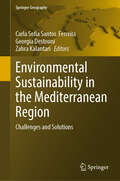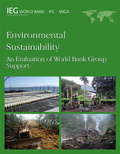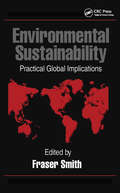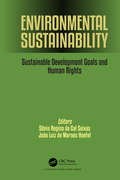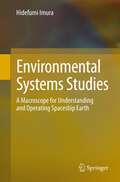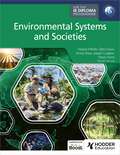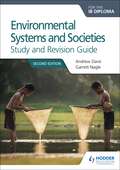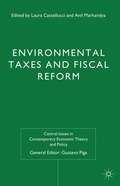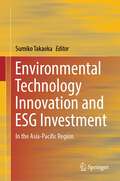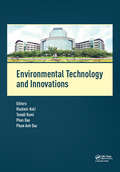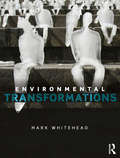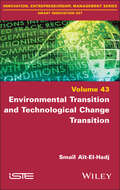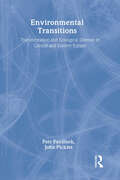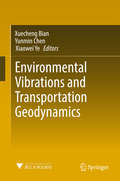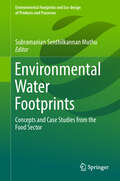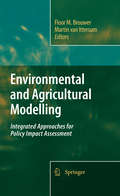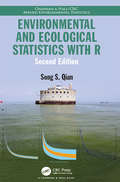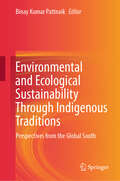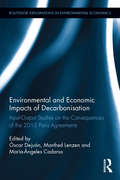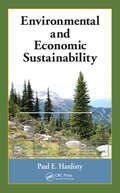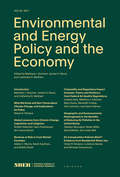- Table View
- List View
Environmental Sustainability in the Mediterranean Region: Challenges and Solutions (Springer Geography)
by Zahra Kalantari Carla Sofia Santos Ferreira Georgia DestouniThe book provides a cross sectoral assessment of the most relevant environmental challenges in the Mediterranean region, including land and water degradation, water and food security, and solution opportunities for these. It also discusses main change drivers, such as changes in climate, land use, population, demographics and technology. Additionally, the book explores improved management, participatory planning, and nature-based strategies and measures for meeting the key environmental challenges, e.g. restoring degraded areas and improving land management in different land uses (e.g. forest, coastal and urban areas). Finally, the book addresses needs and opportunities to improve governance and partnerships for assuring sustainable development in the Mediterranean region.
Environmental Sustainability: An Evaluation of World Bank Group Support
by World BankThis evaluation assesses the Bank Group's support for environmental sustainability in both the public and private sectors over the past 15 years. It identifies several crucial constraints that need to be addressed, perhaps most importantly insufficient government commitment to environmental goals and weak institutional capacity to deal with them. But constraints within the Bank Group, including insufficient attention to longer-term sustainable development, must be reduced as well. The Bank Group needs improved systems in place--across the World Bank, IFC, and MIGA--to monitor environmental outcomes and to assess impacts. Better coordination among the three parts of the Bank Group is also among the key challenges.
Environmental Sustainability: Practical Global Applications
by Fraser SmithIn 1994, representatives from all over the world met in Costa Rica to discuss the impact of ecological economics on developing countries. That groundbreaking conference laid the foundation for this new collection of research on environmental sustainability. While most discussions on sustainable development focus on the industrialized nations, Environmental Sustainability: Practical Global Applications takes a different angle: it presents the views of the developing countries themselves on issues such as wildlife resources in Nambia, timber production in Costa Rica, property rights and land reform in South Africa, and other steps being taken to implement environmentally sustainable economies around the world.This is an ideal text for students of natural and social sciences, development professionals and entrepreneurs seeking opportunities for ecologically sustainable businesses. Academics will find it useful as a source of current research and for making new contacts in the field. For anyone interested in exploring the link between man and his environment-specifically, the relationship between economics and ecology- Environmental Sustainability, is a must.
Environmental Sustainability: Sustainable Development Goals and Human Rights
by Sônia Regina da Cal Seixas; João Luiz de Moraes HoefelUnited Nations 2030 Agenda for Sustainable Development 17 Goals blends the three dimensions of sustainable development: economic, social and environmental. They function as commitments to be met by governments, civil society and the private sector for a 2030 collaborative project. The five keywords to achieve it are: People, Planet, Prosperity, Peace, and Partnerships. Another reading is to link these precepts with the Universal Declaration of Human Rights because to obtain real development we need full realization of human rights. This book analyses Sustainable Development considering Sustainable Development Goals, their importance concerning human rights and its significance for a Sustainable Society.
Environmental Systems Studies
by Hidefumi ImuraThe environmental field is deep and wide. In the flood of information, how can people understand the underlying causes of what they hear about the environment from newspapers and television? This book was originally published in Japanese, with the aim of providing basic information about the ideas and methods to see and understand the interconnection between nature and human activities from a systematic point of view. The author subsequently prepared an English version of the same material for use as a textbook for the Global Environmental Leaders Program at Nagoya University, where he taught many students from Asia and Europe. The book covers diverse environmental issues such as climatic change, biodiversity preservation, energy conservation, and resource recycling. Readers can learn common methods of analysis and thinking to identify the core essence of economic and ecological interdependence, to look at problems from an overarching perspective, and to consider countermeasures to be taken.
Environmental Systems and Societies for the IB Diploma (For the IB Diploma)
by Virginia D'Britto Öykü Dulun Emma Shaw Joseph CazabonDeveloped in cooperation with the International Baccalaureate® Ensure full coverage of the updated syllabus with a coursebook that implements inquiry-based and conceptually-focused teaching and learning, written by highly experienced global authors. - Explore the three key concepts in the new course: perspectives, systems and sustainability which allow students to deepen their understanding and make interdisciplinary connections throughout, with HL content clearly signposted. - Prepare students for assessment with a range of options: exam-style questions, top tip boxes and hints to help avoid common mistakes. - Integrate TOK into lessons and create opportunities for cross-curriculum study with case studies, real world examples and up-to-date data. - Provide plenty of practise with activities, review questions and chapter summaries allowing students to recap themes and test knowledge. - Enable students to feel confident in course terminology with ESL support, definitions, key terms and a glossary.
Environmental Systems and Societies for the IB Diploma (For the IB Diploma)
by Virginia D'Britto Öykü Dulun Emma Shaw Joseph CazabonDeveloped in cooperation with the International Baccalaureate® Ensure full coverage of the updated syllabus with a coursebook that implements inquiry-based and conceptually-focused teaching and learning, written by highly experienced global authors. - Explore the three key concepts in the new course: perspectives, systems and sustainability which allow students to deepen their understanding and make interdisciplinary connections throughout, with HL content clearly signposted. - Prepare students for assessment with a range of options: exam-style questions, top tip boxes and hints to help avoid common mistakes. - Integrate TOK into lessons and create opportunities for cross-curriculum study with case studies, real world examples and up-to-date data. - Provide plenty of practise with activities, review questions and chapter summaries allowing students to recap themes and test knowledge. - Enable students to feel confident in course terminology with ESL support, definitions, key terms and a glossary.
Environmental Systems and Societies for the IB Diploma Study and Revision Guide: Second edition
by Andrew Davis Garrett NagleExam Board: IBLevel: Standard levelSubject: Environmental Systems & SocietiesFirst Teaching: September 2015First Exam: Summer 2017Stretch your students to achieve their best grade with these year round course companions; providing clear and concise explanations of all syllabus requirements and topics, and practice questions to support and strengthen learning. - Consolidate revision and support learning with a range of exam practice questions and concise and accessible revision notes- Practise exam technique with tips and trusted guidance from examiners on how to tackle questions- Focus revision with key terms and definitions listed for each topic/sub topic
Environmental Taxes and Fiscal Reform (Central Issues in Contemporary Economic Theory and Policy)
by Laura Castellucci Anil MarkandyaA review of the literature on environmental taxes, focusing on European experiences, and analysing how such taxes can contribute to green causes as well as reducing the tax burden from "ordinary" taxation. The authors examine the potential 'double dividend' from tax reform for helping the environment, reducing unemployment and encouraging growth.
Environmental Technology Innovation and ESG Investment: In the Asia-Pacific Region
by Sumiko TakaokaThis book focuses on environmental technology and financial markets of the Asia-Pacific region, which includes traditional and emerging innovative countries such as Japan, China, and South Korea. The research and its outcomes presented here are devoted to the nexus between innovation in environment-related technologies, finance, and environmental, social, and governance (ESG) issues. A promising means of achieving a sustainable society is to accelerate innovation in environmental technologies. Chapters of this book tackle some important issues. Using the data on environmental innovation creation and financial markets, the contributors identify three scopes in which ESG performance forms how investors evaluate corporate performance against climate-related risk in the Asia-Pacific capital markets (e.g., corporate bond and credit default swaps); how lenders allocate their credits according to carbon emissions in Japan; and what determines environmental technology creation and how it affects environmental improvement at a country-level. This book thus provides insights into the nexus between innovation in environment-related technologies, finance, and ESG.
Environmental Technology and Innovations: Proceedings of the 1st International Conference on Environmental Technology and Innovations (Ho Chi Minh City, Vietnam, 23-25 November 2016)
by Vladimír Kočí, Tomáš Ruml, Phan Dao & Pham Anh DucThis book covers a wide range of topics within enviromental engineering and technologies including: • General environmental engineering• Clean energy and sustainability• Water and wastewater management• Public health and environment. The application areas range from emerging pollutants of air, soil and water environment, remediation technologies, clean energy and sustainability of biofuels, waste to energy, water and wastewater management, public health and the environment, quality and safety of food production to environmental planning and management and policies for cities and regions. The papers cover both theory and applications, and are focused on a wide range of sectors and problem areas. Integral demonstrations of the use of reliability and environmental engineering are provided in many practical applications concerning major technological approaches. Environmental Technology and Innovations will be of interest to academics and professionals working in a wide range of industrial, governmental and academic sectors, including water and waste management, energy generation, fuel production and use, protection of natural heritage, industrial ecology, man health protection and policy making.
Environmental Transformations: A Geography of the Anthropocene
by Mark WhiteheadFrom the depths of the oceans to the highest reaches of the atmosphere, the human impact on the environment is significant and undeniable. These forms of global and local environmental change collectively appear to signal the arrival of a new geological epoch: the Anthropocene. This is a geological era defined not by natural environmental fluctuations or meteorite impacts, but by collective actions of humanity. Environmental Transformations offers a concise and accessible introduction to the human practices and systems that sustain the Anthropocene. It combines accounts of the carbon cycle, global heat balances, entropy, hydrology, forest ecology and pedology, with theories of demography, war, industrial capitalism, urban development, state theory and behavioural psychology. This book charts the particular role of geography and geographers in studying environmental change and its human drivers. It provides a review of critical theories that can help to uncover the socio-economic and political factors that influence environmental change. It also explores key issues in contemporary environmental studies, such as resource use, water scarcity, climate change, industrial pollution and deforestation. These issues are 'mapped' through a series of geographical case studies to illustrate the particular value of geographical notions of space, place and scale, in uncovering the complex nature of environmental change in different socio-economic, political and cultural contexts. Finally, the book considers the different ways in which nations, communities and individuals around the world are adapting to environmental change in the twenty-first century. Particular attention is given throughout to the uneven geographical opportunities that different communities have to adapt to environmental change and to the questions of social justice this situation raises. This book encourages students to engage in the scientific uncertainties that surround the study of environmental change, while also discussing both pessimistic and more optimistic views on the ability of humanity to address the environmental challenges of our current era.
Environmental Transition and Technological Change Transition
by Smaïl Aït-El-HadjFaced with the scale and intensity of the ecological crisis, environmental transition is underway, consisting of a first phase of technological mutation, aimed at replacing technologies harmful to the environment with those which have no destructive effects on the earth system and its equilibrium. This book examines the roots of the concept of environmental transition, identifying and characterizing the negative effects of technology on the environmental crisis. We will then identify the technological mutations that have the potential to contribute to environmental transition, and demonstrate how these changes are already forming part of a new emerging "technological system". We will conclude by addressing the question of the limits of technological responses to the environmental crisis, demonstrating the importance of the dimensional factors of human activity and weight of growth in this crisis, thus raising the issue of global reconsideration, with reference to the place and articulation of human activity in the Earth system.
Environmental Transitions: Transformation and Ecological Defense in Central and Eastern Europe
by John Pickles Petr PavlínekEnvironmental Transitions is a detailed and comprehensive account of the environmental changes in Central and Eastern Europe, both under state socialism and during the period of transition to capitalism. The change in politics in the late 1980s and early 1990s allowed an opportunity for a rapid environmental clean up, in an area once considered one of the most environmentally devastated regions on earth. The book illustrates how transformations after 1989 have brought major environmental improvements, as well as new environmental problems. It shows how environmental policy, economic change and popular support for environmental movements, have specific and changing geographies associated with them. Environmental Transitions addresses a large number of topics, including the historical geographical analysis of the environmental change, health impacts of environmental degradation, the role of environmental issues during the anti-communist revolutions, legislative reform and the effects of transition on environmental quality after 1989. Environmental Transitions contains detailed case studies from the region, which illustrate the complexity of environmental issues and their intimate relationship with political and economic realities. It gives theoretically informed ideas for understanding environmental change in the context of the political economy of state socialism and post-communist transformations, drawing on a wide body of literature from West, Central and Eastern Europe.
Environmental Values
by Andrew Light John O'Neill Alan HollandWe live in a world confronted by mounting environmental problems; increasing global deforestation and desertification, loss of species diversity, pollution and global warming. In everyday life people mourn the loss of valued landscapes and urban spaces. Underlying these problems are conflicting priorities and values. Yet dominant approaches to policy-making seem ill-equipped to capture the various ways in which the environment matters to us. Environmental Values introduces readers to these issues by presenting, and then challenging, two dominant approaches to environmental decision-making, one from environmental economics, the other from environmental philosophy. The authors present a sustained case for questioning the underlying ethical theories of both of these traditions. They defend a pluralistic alternative rooted in the rich everyday relations of humans to the environments they inhabit, providing a path for integrating human needs with environmental protection through an understanding of the narrative and history of particular places. The book examines the implications of this approach for policy issues such as biodiversity conservation and sustainability. Written in a clear and accessible style for an interdisciplinary audience, this volume will be ideal for student use in environmental courses in geography, economics, philosophy, politics and sociology.
Environmental Vibrations and Transportation Geodynamics
by Xuecheng Bian Yunmin Chen Xiaowei YeThis book includes keynote presentations, invited speeches, and general session papers presented at the 7th International Symposium on Environmental Vibration and Transportation Geodynamics (formerly the International Symposium on Environmental Vibration), held from October 28 to 30, 2016 at Zhejiang University, Hangzhou, China. It discusses topics such as the dynamic and cyclic behaviors of soils, dynamic interaction of vehicle and transportation infrastructure; traffic-induced structure and soil vibrations and wave propagation; soil-structure dynamic interaction problems in transportation; environmental vibration analysis and testing; vehicle, machine and human-induced vibrations; monitoring, evaluation and control of traffic induced vibrations; transportation foundation deformation and deterioration induced by vibration; structural safety and serviceability of railways, metros, roadways and bridges; and application of geosynthetics in transportation infrastructure. It is a valuable resource for government managers, scientific researchers, and engineering professionals engaged in the field of geotechnical and transportation engineering.
Environmental Water Footprints: Agricultural and Consumer Products (Environmental Footprints and Eco-design of Products and Processes)
by Subramanian Senthilkannan MuthuThis book uses case studies to highlight the environmental water footprints in the agricultural and livestock farming sector, and those of consumer products. Water conservation is a major element of every industry’s sustainability strategy.
Environmental Water Footprints: Concepts And Case Studies From The Food Sector (Environmental Footprints And Eco-design Of Products And Processes)
by Subramanian Senthilkannan MuthuThis book discusses the concept of water footprint and corporate water footprint, presenting case studies on a thermal power plant in India and on the food sector. Water conservation is a key element of industrial sustainability strategies.
Environmental and Agricultural Modelling:
by Martin Van Ittersum Floor M. BrouwerAgriculture increasingly faces the challenge of balancing its multiple functions in a sustainable way. Integrated assessment and modelling (IAM) can provide insight into the potential impacts of policy changes. However, concepts to address the wide range of issues and functions typical for agriculture are still scarce. Environmental and Agricultural Modelling reviews and presents our current understanding of integrated and working tools to assess and compute, ex-ante, alternative agricultural and environmental policy options, allowing: 1. Analysis at the full range of scales (farm to European Union and global) whilst focusing on the most important issues emerging at each scale; 2. Analysis of the environmental, economic and social contributions of agricultural systems towards sustainable rural development and rural viability; 3. Analysis of a broad range of issues and agents of change, such as climate change, environmental policies, rural development options, effects of an enlarging EU, international competition, and effects on developing countries.
Environmental and Ecological Statistics with R (Chapman & Hall/CRC Applied Environmental Statistics)
by Song S. QianEmphasizing the inductive nature of statistical thinking, Environmental and Ecological Statistics with R, Second Edition, connects applied statistics to the environmental and ecological fields. Using examples from published works in the ecological and environmental literature, the book explains the approach to solving a statistical problem, covering model specification, parameter estimation, and model evaluation. It includes many examples to illustrate the statistical methods and presents R code for their implementation. The emphasis is on model interpretation and assessment, and using several core examples throughout the book, the author illustrates the iterative nature of statistical inference. The book starts with a description of commonly used statistical assumptions and exploratory data analysis tools for the verification of these assumptions. It then focuses on the process of building suitable statistical models, including linear and nonlinear models, classification and regression trees, generalized linear models, and multilevel models. It also discusses the use of simulation for model checking, and provides tools for a critical assessment of the developed models. The second edition also includes a complete critique of a threshold model. Environmental and Ecological Statistics with R, Second Edition focuses on statistical modeling and data analysis for environmental and ecological problems. By guiding readers through the process of scientific problem solving and statistical model development, it eases the transition from scientific hypothesis to statistical model.
Environmental and Ecological Sustainability Through Indigenous Traditions: Perspectives from the Global South
by Binay Kumar PattnaikThis book explores the environmental and ecological wisdom inherent in some of the indigenous traditions of traditional communities from developing societies like, Argentina, Brazil, India, Mexico, Sri Lanka, and Thailand. It throws light on how these discrete and unrecognized traditions have enabled communities to live in harmony with nature for ages. Despite the best efforts of the modern states through policy-making, intensive R&D for eco-friendly technologies and products, social and environmental impact assessment studies (SEIAS), and cost benefit analysis (CBA) of projects, environmental and ecological degradation continues, mostly in developing societies, which house large number of traditional communities. This book explores their traditions consisting of world views or cosmologies, eco-savvy-customs, indigenous knowledge systems involving community-based occupations and practices, skills and crafts, and so on. This book shows that when interpreted in consonance with scientific environmentalism, these traditions reveal their inbuilt environmental wisdom, mirroring sacredness of nature that have instilled built-in conservation practices, are key to sustainability.The conception of indigenous traditions that subsume environmental and ecological sustainability as well as cultural identity is studied in the book, from the vantage of multi-disciplinary perspectives. This book reflects two streams of thought : (i) stream of social anthropology, arguing for the inbuilt strength of indigenous traditions, that necessitate empathetic understanding with their own rights for recognition and survival, and (ii) stream of indigenous knowledge systems being technically effective only necessitate validation and certification by modern scientific knowledge system for wider use. The book is of great use to policy-makers and non-government players, in addition to researchers and academicians working in the area of sustainable development and indigenous / traditional communities.
Environmental and Economic Impacts of Decarbonization: Input-Output Studies on the Consequences of the 2015 Paris Agreements (Routledge Explorations in Environmental Economics)
by Manfred Lenzen Óscar Dejuán Maria Ángeles CadarsoOn December 12th, 2015, at the United Nations Conference on Climate Change held in Paris, 195 countries adopted the first-ever universal and legally binding climate deal. They agreed to decarbonize the economy in order to hold the increase in the global average temperature to well below 2ºC relative to the preindustrial levels. Although each country is free to design its own strategy on mitigation and adaptation, it will be bound to such strategy and is supposed to implement the bulk of the adjustments by 2050. Many questions arise from the Paris Agreement that points to a second Industrial Revolution. What are the required changes in the structure of production and in the patterns of consumption? What will be their impacts on emissions, employment and international trade? This book answers these questions from a variety of input-output models able to compute the impacts on specific sectors and regions. This volume has 17 chapters written by 52 co-authors who are specialists in input-output analysis and environmental sustainability. They come from 24 universities, research centers and international agencies all over the world, sharing their commitments to explain important and complex ideas in a way that is understandable to the non-experts and experts alike. Environmental and Economic Impacts of Decarbonization is a very important read for those who study environmental economics, climate change and ecological economics.
Environmental and Economic Sustainability
by Paul E. HardistyNever before has the quest to balance the needs of people, the environment, and the economy been so important. While sustainability has been widely taken up by governments and business, the world has continued to move in increasingly unsustainable directions, from continued dependence on fossil energy to rising greenhouse gas emissions, and erosion
Environmental and Energy Policy and the Economy: Volume 1 (NBER-Environmental and Energy Policy and the Economy #1)
by The University of Chicago PressThis volume presents six new papers on environmental/energy economics and policy. Robert Stavins evaluates carbon taxes versus a cap-and-trade mechanism for reducing greenhouse-gas emissions, arguing that specific design features of either instrument can be more consequential than the choice of instrument itself. Lucas Davis and James Sallee show that the exemption of electric vehicles from the gasoline tax is likely to be efficient as long as gasoline prices remain below social marginal costs, even though it results in lower tax revenue. Caroline Flammer analyzes the rapidly growing market for green bonds and highlights the importance of third-party certification to the financial and environmental performance of publically traded companies. Antonio Bento, Mark Jacobsen, Christopher Knittel, and Arthur van Benthem develop a general framework for evaluating the costs and benefits of fuel economy standards and use it to account for the differences between several recent studies of changes in these standards. Nicholas Muller estimates a measure of output in the U.S. economy over the last 60 years that accounts for air pollution damages, and shows that pollution effects are sizable, affect growth rates, and have diminished appreciably over time. Finally, Marc Hafstead and Roberton Williams illustrate methods of accounting for employment effects when evaluating the costs and benefits of environmental regulations.
Environmental and Energy Policy and the Economy: Volume 2 (NBER-Environmental and Energy Policy and the Economy #2)
by The University of Chicago PressThis volume presents six new papers on environmental and energy economics and related policy issues. Robert Pindyck provides a systematic overview of what is known, and remains unknown, about climate change, along with the implications of uncertainty for climate policy. Shaikh Eskander, Sam Fankhauser, and Joana Setzer offer insights from a comprehensive data set on climate change legislation and litigation across all countries of the world over the past thirty years. Adele Morris, Noah Kaufman, and Siddhi Doshi shine a light on how expected trends in the coal industry will create significant challenges for the local public finance of coal-reliant communities. Joseph Aldy and his collaborators analyze the treatment of co-benefits in benefit-cost analyses of federal clean air regulations. Tatyana Deryugina and her co-authors report on the geographic and socioeconomic heterogeneity in the benefits of reducing particulate matter air pollution. Finally, Oliver Browne, Ludovica Gazze, and Michael Greenstone use detailed data on residential water consumption to evaluate the relative impacts of conservation policies based on prices, restrictions, and public persuasion.
